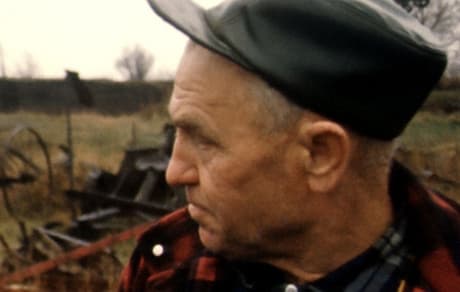William Kurelek's The Maze (a re-imagined hour-long documentary that uses decades-lost footage from filmmakers Robert M. Young and David Grubin) examines the art and life of the celebrated (if mostly posthumously) Canadian artist.
During work on a 1969 film dealing with "psychotic art," Young became fascinated by Kurelek's painting "The Maze," a depiction of the "inside" of the artist's "skull" made while he was being treated for clinical depression and suspected schizophrenia in 1953.
The trope of the "crazy" artist is a powerful one. Even people unfamiliar with art history know Vincent Van Gogh — the unofficial patron saint of mental illness. While Kurelek's psychological issues aren't as well known as Van Gogh's, his early work uses art as a therapeutic tool. So it's understandable how and why the filmmakers would be interested in investigating his mental distress and "extreme feelings of unreality" while simultaneously showcasing the very art he created during and after his stint in psychiatric hospitals.
Interview footage with the artist, his family, members of his medical team and his priest shows each speaking with surprising candour about Kurelek's beliefs, traits and life. Through the course of this documentary, the young Kurelek seems less crazy than sensitive and uncertain about how to live as an artist. His "hard and ambitious" immigrant father's strict notion of success and dismissive attitude towards Kurelek's artistic tendencies have left him feeling isolated and misunderstood.
Few of us live without anxiety or fear — we fear eschewing social conventions and expectations, we don't want to disappoint others or ourselves, we wonder how to live a meaningful life. Through Kurelek's example, this documentary outlines the hardships associated not just with trying to make sense of choosing an unconventional path, but of merely being alive.
There is something fascinating about witnessing an artist articulate his thoughts without censor or shame. Whenever people are able to discuss their struggles and successes, their neuroses and hopes with authenticity, as Kurelek does in this documentary, it feels like a gift. The artist's recollection of the life-changing revelation he experienced after undergoing 14 electroshock therapy sessions, a time he considers a "spiritual crisis," is almost uncomfortably intimate.
Like in the documentary In the Realms of the Unreal, William Kurelek's The Maze uses an amplified "Ken Burns Effect" to illustrate the interviewees' words and provide a compelling narrative arc. Not only does this documentary pan along and zoom in on still imagery — in this case, Kurelek's paintings and drawings — but it also makes certain figures move, gesticulate or sing.
When the work of an artist is looked at solely through the lens of their autobiography, however, there is a danger of reductionism. While the visual manipulation of Kurelek's paintings is intriguing and effectively affective, it also ascribes fixed meaning onto images that should remain unbound.
During work on a 1969 film dealing with "psychotic art," Young became fascinated by Kurelek's painting "The Maze," a depiction of the "inside" of the artist's "skull" made while he was being treated for clinical depression and suspected schizophrenia in 1953.
The trope of the "crazy" artist is a powerful one. Even people unfamiliar with art history know Vincent Van Gogh — the unofficial patron saint of mental illness. While Kurelek's psychological issues aren't as well known as Van Gogh's, his early work uses art as a therapeutic tool. So it's understandable how and why the filmmakers would be interested in investigating his mental distress and "extreme feelings of unreality" while simultaneously showcasing the very art he created during and after his stint in psychiatric hospitals.
Interview footage with the artist, his family, members of his medical team and his priest shows each speaking with surprising candour about Kurelek's beliefs, traits and life. Through the course of this documentary, the young Kurelek seems less crazy than sensitive and uncertain about how to live as an artist. His "hard and ambitious" immigrant father's strict notion of success and dismissive attitude towards Kurelek's artistic tendencies have left him feeling isolated and misunderstood.
Few of us live without anxiety or fear — we fear eschewing social conventions and expectations, we don't want to disappoint others or ourselves, we wonder how to live a meaningful life. Through Kurelek's example, this documentary outlines the hardships associated not just with trying to make sense of choosing an unconventional path, but of merely being alive.
There is something fascinating about witnessing an artist articulate his thoughts without censor or shame. Whenever people are able to discuss their struggles and successes, their neuroses and hopes with authenticity, as Kurelek does in this documentary, it feels like a gift. The artist's recollection of the life-changing revelation he experienced after undergoing 14 electroshock therapy sessions, a time he considers a "spiritual crisis," is almost uncomfortably intimate.
Like in the documentary In the Realms of the Unreal, William Kurelek's The Maze uses an amplified "Ken Burns Effect" to illustrate the interviewees' words and provide a compelling narrative arc. Not only does this documentary pan along and zoom in on still imagery — in this case, Kurelek's paintings and drawings — but it also makes certain figures move, gesticulate or sing.
When the work of an artist is looked at solely through the lens of their autobiography, however, there is a danger of reductionism. While the visual manipulation of Kurelek's paintings is intriguing and effectively affective, it also ascribes fixed meaning onto images that should remain unbound.
